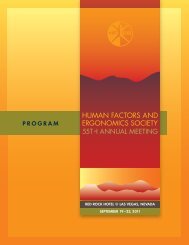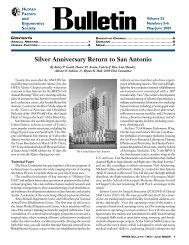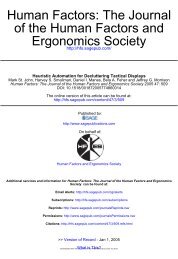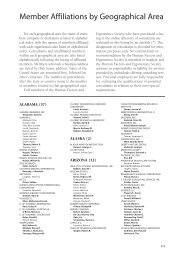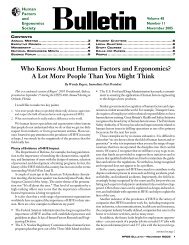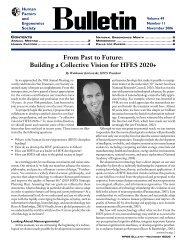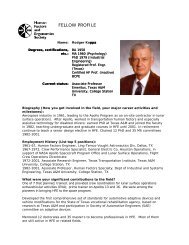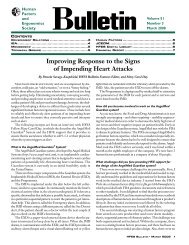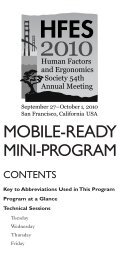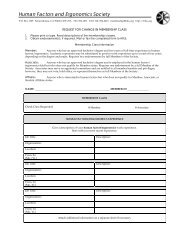Next Generation Air Transportation System Integrated Plan
Next Generation Air Transportation System Integrated Plan
Next Generation Air Transportation System Integrated Plan
Create successful ePaper yourself
Turn your PDF publications into a flip-book with our unique Google optimized e-Paper software.
Chapter 5: The <strong>Next</strong> <strong>Generation</strong> <strong>Air</strong><br />
<strong>Transportation</strong> <strong>System</strong> Roadmap for Success<br />
While achieving the vision for air transportation will be done via<br />
collaboration among federal, state, and local governments and private<br />
industry, the essential purpose of the vision will be to establish a stable<br />
and transparent framework that encourages private sector innovation.<br />
All of these efforts will be coordinated through eight major strategies<br />
that broadly address the goals and objectives for the <strong>Next</strong> <strong>Generation</strong><br />
<strong>Air</strong> <strong>Transportation</strong> <strong>System</strong> (NGATS). Supporting these strategies will<br />
be a combination of research, development, and implementation<br />
activities. These activities will involve a review of policy and financial<br />
mechanisms as well. The eight major strategies, along with their key<br />
research areas, are presented in this next section.<br />
5.1 Strategies<br />
1. Develop <strong>Air</strong>port Infrastructure to Meet Future Demand<br />
Strategy:<br />
• Provide a system that meets or exceeds user demand by<br />
integrating airport, airspace and air traffic management<br />
design, development, and deployment. <strong>Air</strong>port<br />
infrastructure must address the need to expand in a way<br />
that meets future capacity while satisfying the other<br />
objectives. This strategy provides customers a wide-range of<br />
options for air transportation in an efficient cost-conscious<br />
manner.<br />
Research areas:<br />
• Develop requirements and concepts for servicing a variety<br />
of future demands, from maximizing overall metropolitan<br />
area capacity to servicing smaller communities. Groundside<br />
questions include airport access alternatives and<br />
associated transportation, security, and information<br />
systems requirements, such as regional airports and city<br />
check-in by specific location.<br />
2. Establish an Effective Security <strong>System</strong> Without Limiting<br />
Mobility or Civil Liberties<br />
Strategy:<br />
• Establish a global security system to ensure reservationto-destination<br />
security for travelers and the stream of<br />
commerce. Travelers and shippers will be confident that no<br />
undue security or health risks exist in the transportation<br />
system, and that movements and civil liberties are not<br />
unduly impeded by security measures.<br />
Research areas:<br />
• Explore integrated, scalable security methods and<br />
implementation to mitigate potential threats to the air<br />
transportation system.<br />
• Develop advanced sensors, information systems, and<br />
mitigation strategies for identifying threats and recovery<br />
from attack.<br />
• Develop automated security screening of passengers,<br />
baggage, and cargo integrated into the normal flow of<br />
people and items.<br />
• Improve chemical, radiological, biological, and health<br />
sensors, including automation for detection and<br />
recognition of hazardous items.<br />
3. Establish an Agile <strong>Air</strong> Traffic <strong>System</strong><br />
Strategy:<br />
• Establish an agile air traffic system that accommodates<br />
future requirements and readily responds to shifts in<br />
demand from all users. The system will be responsive to<br />
market elasticity, have the flexibility to deliver capacity and<br />
efficiency improvements, and ensure that equipment and<br />
personnel are able to support a wide range and number of<br />
operations tailored to customer needs.<br />
Research areas:<br />
• Conduct research to evaluate alternative allocations of air<br />
traffic management services and functions between the<br />
ground and the air, and the automation and the human,<br />
to address critical system attributes such as capacity, agility,<br />
cost, human factors, reliability, safety, performance, and<br />
transition paths.<br />
• Determine the requirements for communications,<br />
navigation, and surveillance infrastructure to meet the<br />
traffic and performance needs of the future in a costeffective<br />
manner while accommodating all air traffic,<br />
defense, and security stakeholders.<br />
• Define and evaluate fundamental communications,<br />
navigation, and surveillance architecture options, such as<br />
moving to digital data links and away from voice command<br />
and control, satellite-based-only or continued reliance on<br />
ground-based communications systems, spectrum and<br />
bandwidth needs and likely spectrum availability.<br />
• Investigate feasible architecture options that allow all<br />
aircraft to operate the same within specific airspace.<br />
• Develop cost-effective concepts, technologies, and procedures<br />
for providing comprehensive air traffic services at small<br />
airports.<br />
• Define a portfolio of the most effective alternatives for<br />
expanding airfield capacity.<br />
• Undertake research on cost-effective technologies,<br />
procedures, or other actions needed to make instrument<br />
Joint <strong>Plan</strong>ning & Development Office 15



